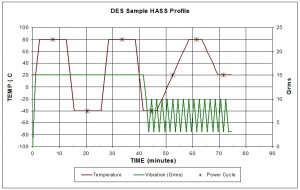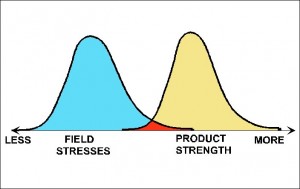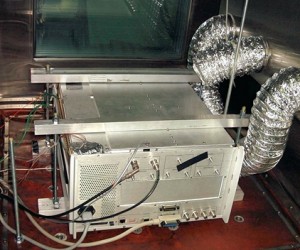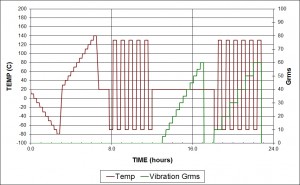Product reliability is essential to success in today’s competitive global market. HALT and HASS are intensive methods used to expose and then improve design and process weaknesses. HALT and HASS are faster, less expensive and more accurate than traditional testing techniques. HALT and HASS are proven processes used to lower product development and manufacturing costs, compress time to market, reduce warranty costs, improve customer satisfaction, gain market share and increase profits. Some companies have reported savings in the millions after using HALT and HASS.
HALT and HASS can accelerate a product’s aging process from actual months into test minutes much faster than traditional testing!
What is HALT?
HALT – Highly Accelerated Life Testing
HALT is used to find product design weaknesses making the product more rugged.
- HALT is typically done during Design. It is destructive!
- Stresses are applied in steps to find a product’s weaknesses, operational design margins, and destruct limits.
- Stresses are higher than normal to obtain time compression and accelerate aging.
- HALT is not a pass/fail test. It is pro-active! The stresses are increased until the product fails, rather than testing to predefined limits.
- All HALT failures represent an opportunity for improvement and may show up in the field.
- Many failures are easy and inexpensive to fix.
- HALT typically takes 3 to 5 days.
What is HASS?
HASS – Highly Accelerated Stress Screening
HASS is used to find defects and flaws in production to monitor the quality and consistency of your manufacturing processes.
- HASS is done during Manufacturing.
- HASS is a screening method used to expose manufacturing process problems that would cause a failure in normal field environments including shipping, storage and use.
- Stresses may be higher than normal operation to precipitate defects in a short amount of time. HASS stresses are typically higher than traditional Environmental Stress Screening (ESS).
- Types of stresses used are similar to those used in HALT.
- HASS screens take typically from an hour to a few hours.
- HALT must be performed before HASS.
- Safety of Screen (SOS) is used to validate the screen proving that sufficient life is left for a normal use lifetime.
Reasons to Use HALT/HASS
- To produce a rugged, reliable product.
- Products have many electronic parts subjected to combined high/low temperature and vibration loads. Many parts are not tested for these combined loads.
- With thousands of electronic components present, a failure of a single component could cause the entire system to fail. This will lead to warranty and engineering redesign costs, and unhappy customers.
- To find and understand the operating limits of your products.
- To find and understand the destruct limits of your products.
- To compare different electronic components and suppliers (Evaluation of Competing Vendors).
- To regularly audit or screen your production components to check for and improve manufacturing quality.
Typical Stresses Used in HALT and HASS Testing
- Vibration applied over a broad frequency range (6 DOF, 60 Grms, Random vibration energy to 10,000 Hz)
- Temperatures (-100°C to +200°C)
- High temperature rate of change (60°C / minute)
- Electrical loads
- More stresses (fluid pressure and viscosity, pH, unbalance, geometry, etc.)
- Combination of all loads

Why Products Fail

Every product has a statistical strength distribution. Failures will occur where the Product Strength and Field Stress Curves overlap shown in red. HALT/HASS will force the weaker components to fail in the chamber. HALT and HASS will shift the Product Strength curve to the right. The goal of HALT/HASS is to produce a large design margin or gap between the 2 curves, resulting in less field failures and a more reliable product!
Benefits of HALT

- Shorter design cycle = Quicker Time to Market.
- Reduced design cost.
- Usually less expensive, faster, and more effective than traditional pass/fail testing.
- Find and improve design margins.
- Produce a more rugged/reliable product with less field failures and warranty expenses.
- Reliable products lead to happy customers.
- Happy customers lead to increased profits/market share.
- ROI’s in the thousands or greater are being reported.
Benefits of HASS
- HASS screens are shorter than traditional methods (ESS).
- Reduced time and cost to screen production.
- Finds defects sooner and correct problems faster.
- Fewer defects reach the customers hands.
- Improved product quality and manufacturing process control.
DES reliability testing can help you in all phases of your project.

Hi,
First thanks for the explanation,
Second, the graph done by XLS? is yes can i get the graph file,
Regards,
Amir